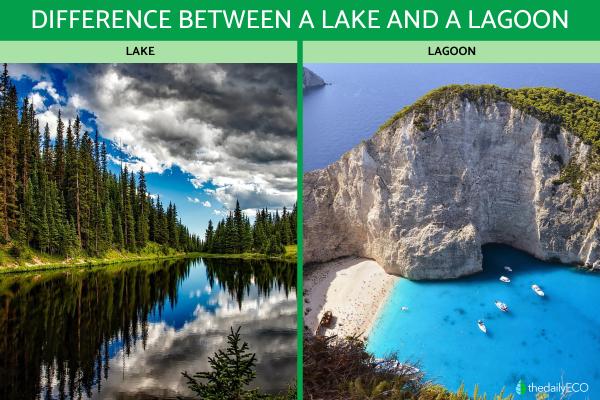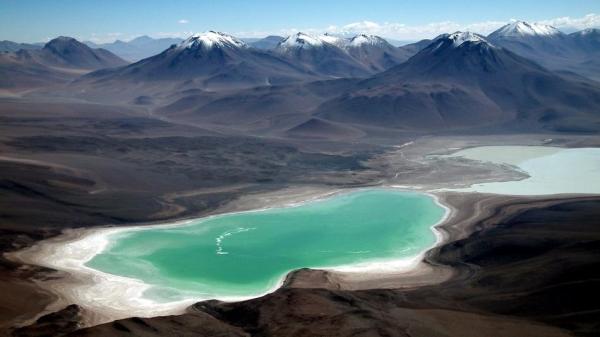
Lakes, lagoons, rivers, ponds, seas or oceans are all types of bodies of water. Some are much bigger than others, but size is not the only difference between them. Since so many of the world's bodies of water and waterways are so interconnected, it can sometimes be difficult to tell the difference between one and another. This is especially so when we take into consideration the fact that about 70% of the total surface area of our planet is covered in water.
While we may have some concept our world's largest bodies of water, once we get into stream, tributaries, estuaries and the like, it can seem a little confusing. This is why thedailyECO explains the differences between a lake and a lagoon by explain their different features and characteristics.
What is a lake?
Lakes are bodies of water, which are almost always a majority of freshwater. They can be very large, but they are always separated from the sea. The water in the lakes can come from both rivers and streams, as well as from groundwater or rain.
Not only do they have a water inlet, they also have outlets in the form of rivers or other outlets which connect to the sea. This means the water is never stagnant, but rather there is a current, even it is often not perceptible. There are salt lakes which are high in salinity, but the salt doesn't come from sea water. If it is a lake, it is not part of a sea.
At this point it should be noted that those very large lakes that do not have access to the sea can also be known as a closed sea. Perhaps the most classic example is that of the Caspian Sea, which is actually a lake.
What is a lagoon?
Lagoons are natural water deposits separated from the sea, but always in coastal regions. They are shallow and their waters are either salty or brackish. As a result of its shallow depth and its sedimentation, lagoons are usually places where a lot of vegetation grows and are home to a large amount of fauna. Unlike lakes, where only plants grow on the margins, the lagoon can contain rooted plants along its entire length.
Now that we know the definitions of lake and lagoon, it is likely that we still have doubts about their differences. Below we explain them in detail so you can have an easy comparison between a lake vs. lagoon.

Differences between lake and lagoon
In general terms, the differences between lake and lagoon are the following:
- Differences in depth
- Whether the water is stagnant
- Whether they are fresh or salt water
- Water temperature
- Dewatering
Next, we will explain in detail the differences between lake and lagoon for each of these aspects.
Depth
Although many people believe a key element is size, the reality is that the most important thing to establish whether it is a lake or a lagoon is depth. The shallowness of the lagoons is an essential difference with a lake. It is not possible to establish clear limits, since these depend on the area and the country. For example, in Spain the limit is marked at 15 m while in the US the limit depth is 3 m. Despite these differences, a lagoon is always shallow, unlike a lake, which is always deeper. However, it is true that in general a lake is bigger than a lagoon.
Stagnant water
The lagoon only has a water inlet and no outlet, while the lake has both inlets and outlets. Obviously, in lakes, most of the time more water enters than leaves. If this didn't happen, they would disappear. Although there may be a sensation of stagnant water, in reality it is in constant movement. Unlike lakes, lagoons are stagnant bodies of water.
Fresh or salt water
Although this is a key difference, salinity is not a 100% reliable distinction between lakes and lagoons. This is because we find water of a different nature in both lakes and lagoons. It can serve as a guiding factor when establishing the differences between a lake and a lagoon.
In general, the lagoons are salt water, either because they are located next to the sea separated by an arm of land or because their sedimentation provides some salts that this nature gives them. For their part, lakes are usually freshwater. Slat lakes can have various deposits of salt from other sources.
Water temperature
This is related to the point of depth. As the lagoons are very shallow, the sun's rays heat their waters evenly, so all the water has the same temperature. The difference between the lagoon and the lake is that the latter, as it is deeper, creates different temperature layers depending on the depth of the water. In general, the surface waters are warmer, while the lower ones are colder.
Dewatering
As we have already explained, one of the differences between a lake and a lagoon is that lagoons do not have a water outlet. Whether due to a drought or another reason, when the lagoon fails to feed itself with water, it will end up disappearing. This leads us to ask what are the differences between the dewatering of the lagoon and the lake? While the lagoons evaporate or filter out water, lakes disappear when more water leaves towards the rivers and streams than enters through other sources.
Learn more information about different bodies of water with our guide to inland waters.
If you want to read similar articles to Differences Between a Lake and a Lagoon, we recommend you visit our Ecosystems category.